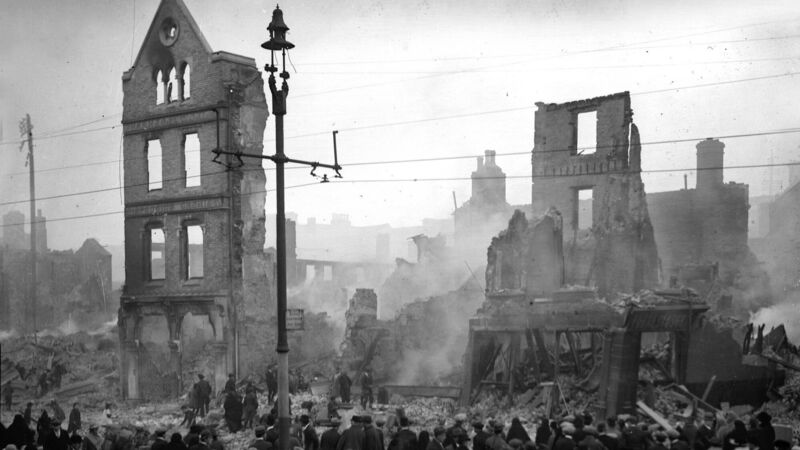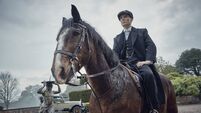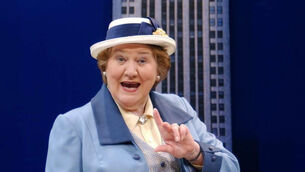New novel from Ger Fitzgibbon set during the burning of Cork

Crowds of onlookers throng Patrick Street on the day following the burning of Cork in 1920. Ger Fitzgibbon's novel is set during that fateful night. Picture: Irish Examiner Archive
Former head of drama and theatre studies at UCC and now a freelance writer and director, Ger FitzGibbon has just published his debut novel, Songs for a Burning City. It is set on the evening of December 11, 1920 when a production of The Gondoliers is in full swing at the Cork Opera House. Word comes through that the Crown forces are rampaging through the streets of Cork, setting buildings on fire.
The novel is an imagined history as seen through the eyes of cast members and the audience at the Gilbert & Sullivan opera. For some, it’s an opportunity for looting, or even romance. For others, the dramatic night will change the direction of their lives.
With an extensive dramatis personae (helpfully included in the publication), FitzGibbon was keen to focus on ordinary bystanders and how the terrible events affected them.
“It’s worth remembering that in all of County Cork, there were less than 500 active IRA members in this period,” says FitzGibbon. “There were, however, a great many passive supporters, or people on the periphery. The vast majority of people were non-combatants, with a very wide variety of political opinions and none.
"I guess, in part, writing a book like this allows you to explore that diversity of possible reactions and responses. In the course of the novel, several characters undergo real challenges and changes as they deal with what’s unfolding around them.”
Up to now, the former lecturer has been a professionally-produced playwright. “Writing a novel wasn’t something I had really planned. I think covid turned a lot of things around in that people were writing and finding new ways of expressing themselves. This book arose from a project that I’d been involved in with a few other people. We were trying to persuade City Council to do something big and spectacular around the burning of the city for its 100th year commemoration. It needed substantial seed funding to get the thing planned. We were looking at a major event in the centre of town.”

But the pandemic put a stop to the ambitious plan being expedited. However, not one to waste an idea and a lot of research, FitzGibbon started to write his novel. “I just found it fascinating. I’m interested in Irish history, particularly in the first 20 years or so of the 20th century, the period leading up to the Rising and the Civil War. I had written a play about that period called Johnno’s Wars. And the stuff about the burning of Cork intersected with my own family history. My mother’s family (her maiden name was Murray) grew up in Mary Street. Her father was a cabinet maker. There was a big family of them.
"An interesting thing about them was that my mother’s sister was in Cumann na mBan. Two of her brothers were in the Cork Operatic Society. I discovered that there was a bit of tension between them because the brothers didn’t want their social lives disrupted by the sister’s activities, so to speak. I just thought that was an interesting dynamic in a household.” In the novel, just one woman from Cumann na mBan makes an appearance.
FitzGibbon says that getting the period detail right was a hard slog. "I read newspapers from the time and checked what people were wearing. There’s interesting photographs in St Peter’s on North Main Street from around that period. One is of a Michael Collins gathering on Patrick Street and another is of a De Valera gathering on the street.
"You realise that in the De Valera gathering, the vast majority of men are wearing caps whereas in the Michael Collins photo, the men are wearing hats. There’s a slight class distinction there as the cap is the working man’s badge... I was very conscious of wanting a wide spread of different classes of people in the novel.”
One man in the narrative that wears his new hat proudly is Larry McDonald, a clerk. He rather fancies himself. He is part of a love triangle. He and his quieter, stammering brother, Tom, have designs on Minnie Barriscale, a member of the chorus in the opera.
Fitzgibbon says the dialogue in the novel came easily to him thanks to his experience of crafting plays, but he found it difficult to maintain a structure as there are multiple narratives occurring on the one night. He credits novelist Mary Morrissy with giving him plenty help along the way. "She mentored me during the process of putting it together, finding a shape that would encompass all of it.”
- Songs for a Burning City is out now, published by Menma Books. www.menmabooks.eu




